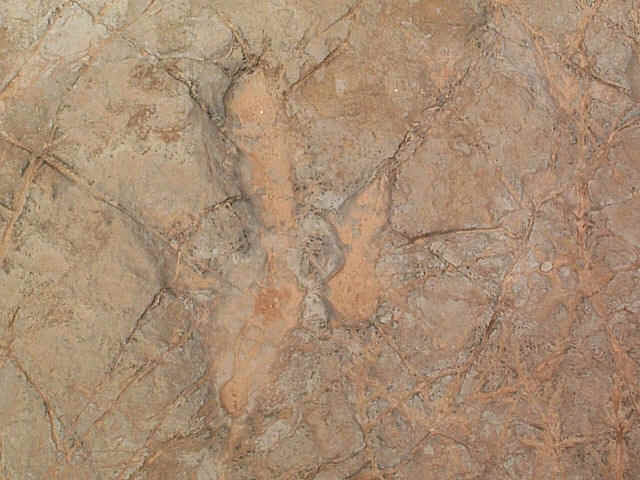
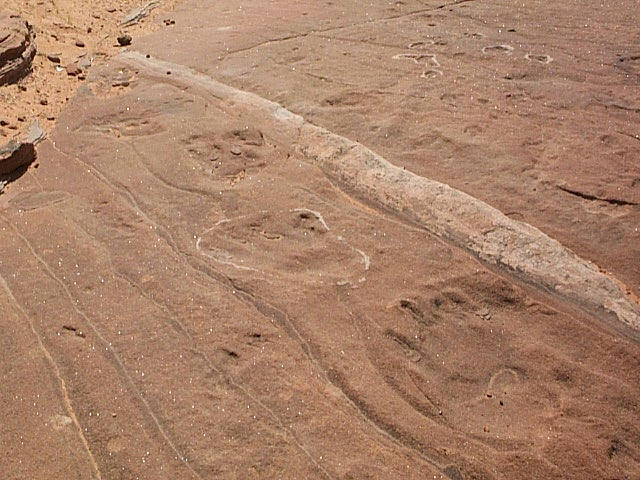
Theropod Prosauropod
Vertebrate trace fossils
One common type of trace fossils in the Navajo Ss are footprints. The footprint record reveals the presence of new varieties of dinosaurs, other reptiles and what appear to be primitive mammals. They range in size from tiny birdlike footprints barely an inch long to much larger 3 and 4 toed tracks up to 12" long.
Dinosaur tracks


Theropod
Prosauropod
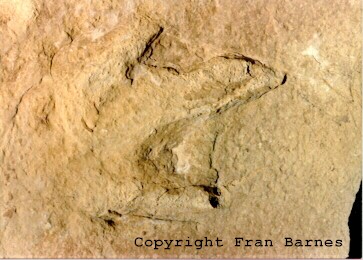
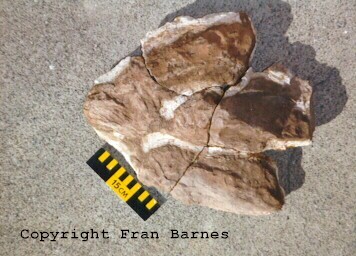
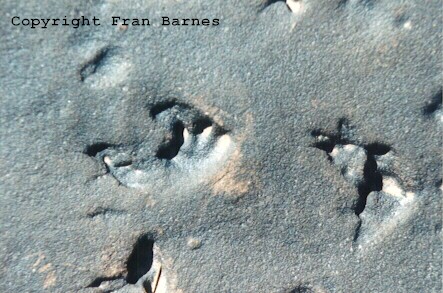
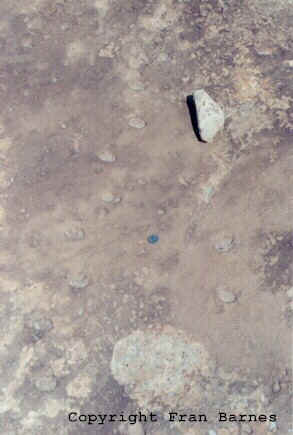
Possible
Pterosaur tracks
Possible tritylodont tracks
Below is a list of the ichnotaxa known from the Navajo as described in Emma Rainforth's 1997 Master Thesis (Univ. of Colorado).
| Ichnotaxon (track name) |
# Functional Digits | Biped or Quadruped? | Footprint length (cm) | Hip Height
(cm) (4 times foot length) |
Possible Trackmaker |
| Grallator | 3 | Biped | <18 | <75 | Ceratosaur – small |
| Anomoepus | 3 | Biped | <16 | <65 | Ceratosaur – small |
| Cf. Sauropus | 3 | Biped | 14 | about 55 | Ceratosaur – small |
| Cf. Apatichnus | 3 | Biped | 20 | 80 | Ceratosaur – small |
| Cf. Wildeichnus | 3 | Biped | <5 | <20 | Ceratosaur – tiny/juvenile |
| Trisauropodiscus moabensis |
3 | Biped | <6 | <25 | Ceratosaur – tiny/juvenile |
| Anchisauripus | 3 | Biped | 12-30 | 50-120 | Ceratosaur – medium |
| Eubrontes | 3 | Biped | >25 | >100 | Ceratosaur – large |
| Dilophosauripus | 3 | Biped | 20-35 | 80-140 | Ceratosaur – large |
| Tridactyl morph A | 3 | Biped | 20-25 | 80-100 | Ornithischian |
| Otozoum moodii | 4 | Biped or Quad. | 30-36 | 120-140 | Thyreophoran |
| Otozoum minus | 4 | Biped | about 30 | about 120 | Thyreophoran |
| Navahopus falcipollex | 3 | Quadruped | 13-15 | 50-60 | Prosauropod |
| Cf. Navahopus | 4 | Quadruped | 20 | about 80 | Prosauropod |
| Tetradactyl morph A | 4 | unknown | 5 | 20 | Unknown |
| Brasilichnium | 5 | 4 | <7 | <30 | Protomammal/mammal |
| Batrachopus | 4 | 4 | 5 | 30 | Crocodylomorph/protomammal |
| "Lacertilian" | 5 | ?Quadruped | <5 | <20 | Lacertilian |
| Pteraichnus | 4 | Quadruped | <6 | <25 | Pterosaur – rhamphorhynchid |
Grallator
- Small (up to 18 cm long) tridactyl track with well-defined pad and claw impressions. Narrow divarication.Eubrontes -
Large (longer than 25 cm) tridactyl track with well-defined pad and claw impressions. Narrow divarication.Anchisauripus -
Medium-sized (15-30 cm long) tridactyl track with well-defined pad and claw impressions. Narrow divarication.Anomoepus -
Small tridactyl track with well-defined pad and claw impressions; metatarsal impression often present. Wider divarication than Grallator but it is likely that Anomoepus is a behavioral variant of Grallator since a single trackway from the Newark Supergroup changes from Grallator to Anomoepus.cf.
Sauropus - Small tridactyl track with well-defined pad and claw impressions. Extremely narrow divarication – digits are almost parallel. See Lull, 1953 and Figure 8. It is possible that this ichnogenus is a behavioral variant of Grallator; it may be a junior synonym.cf.
Apatichnus - Small tridactyl track with well-defined pad and claw impressions. Track is asymmetrical – divarication between digits II and III is much less than that between digits III and IV. This ichnogenus may be a behavioral variant of Grallator.cf.
Wildeichnus - Very small (up to 5 cm long) tridactyl track with narrow divarication. Pad impressions may be present. See Haubold, 1971 and Figure 3. This ichnogenus may be a juvenile Grallator.Trisauropodiscus moabensis -
Very small (up to 6 cm long) tridactyl track with very wide divarication. Pad impressions present but indistinct. This ichnogenus may be a juvenile Anomoepus (and therefore possibly a juvenile Grallator), although it also resembles some Early Cretaceous bird tracks.Dilophosauripus -
Large tridactyl track with fairly well-defined pad and claw impressions. Quite wide divarication. This ichnogenus may be a behavioral variant of Eubrontes.Tridactyl morph A - This track morphology occurs at several sites in the Navajo. A small to medium sized tridactyl track lacking ungual impressions; the distal ends of digits are blunt and rounded. Digits are slightly curved. Phalangeal impressions are absent – each digit comprises a single cigar-shaped pad, indicative of a very fleshy foot, possibly with reduced digital flexibility. Short metatarsal impression may be present. These tracks are often found as single tracks on small float blocks; Manus tracks are unknown, suggesting a bipedal trackmaker.
Otozoum -
Usually bipedal trackway. Pes large (up to 50 cm long), functionally tetradactyl, manus small, functionally tetradactyl. Claws present on both manus and pes tracks.Navahopus -
Subcircular pes approximately 14 cm long, claw impressions visible but no pads on digits. Tridactyl, but some impressions apparently tetradactyl. Manus tracks tridactyl; digit I directed inwards perpendicular to midline of trackway; digits II and III directed forwards. Manus smaller than pes, approximately 4 cm long and 5-8 cm wide (variability in track size due to variation in digit I orientation). It has been suggested that this ichnogenus is simply a large Brasilichnium (Lockley and Hunt, 1995); however the morphological differences between these two ichnogenera are too great to be attributed to preservational differences.cf.
Navahopus - Quadrupedal trackway. Pes oval, tridactyl or tetradactyl (unclear from the material described and illustrated by Faul and Roberts, 1951), up to 15 cm long. Manus possibly tetradactyl, very similar in size to pes. These tracks from the Navajo in Colorado were assigned to Tetrasauropus by Baird (1980); however this ichnogenus is much larger (pes length >>25 cm) than the tracks figured by Faul and Roberts (1951).Tetradactyl morph A - This track morphology is represented by a single track in the Navajo. It is preserved as a cast in eolian sandstone. It is unknown whether it is a manus or pes track, or whether the trackmaker was a biped or quadruped.
Brasilichnium -
Quadrupedal trackways. Pes subcircular, pentadactyl, although often not all the digits are preserved. Digits represented by claw impressions only. Pes usually less than 5 cm long. Manus rarely preserved, possibly because most of the animal’s weight was borne on it’s hind legs; where seen it is much smaller than the manus, and possibly tridactyl – due to it’s size, and preservation on dune foresets, morphological detail is difficult to discern.cf.
Batrachopus - Small tetradactyl pes and manus. Pes digits increase in size from I to III, digit IV is slightly smaller than digit III. In the Aztec such tracks are approximately 7 cm long (Reynolds, 1989). It unlikely that these examples are distorted Brasilichnium, because:"Lacertilian" - Supposed lacertilian tracks have been
reported from a single site in the Navajo (Sand Wash, UCD L-00287; Lockley and Hunt,
1995). These have not been adequately illustrated or described.
Pteraichnus - Pterosaurian tracks were reported from the same site
(and slab) as the "lacertilian" tracks mentioned above. See Stokes and
Madsen, 1979 for description of the Navajo examples; Lockley et al., 1995 for a review of
all known pterosaur tracks; and Lockley and Hunt, 1995 for an illustration of the
"pterosaur" track-bearing slab.
Brasilichnium is the trace fossil name given to small, oval tracks (1-3") that were probably formed by mammal-like reptiles such as tritylodont. Extensive burrow perhaps made by these same creatures are prominent in certain areas.
Vertebrate burrows are a signature feature of the Navajo. A typical diameter is about 4-8". The extensive nature of the borrows would appear to indicate that these were social animals. Some of the fossilized borrows are solid, some are hollow and others are partically filled with limestone deposits. Tritylodonts were known burrowers and could have caused many of these burrows but a thorough investigation and inventory is lacking at the present time.
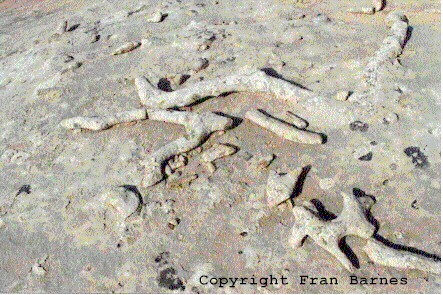

Burrow Cross-Section

Vertebrate Skeletal Fossils Invertebrate Skeletal Fossils
Vertebrate Trace Fossils Invertebrate Trace Fossils
Petrified Wood and Flora Casts Fresh Water Deposits
Moab Specimens Miscellaneous and the Curious